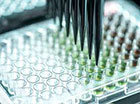Challenge
Laboratories are faced with the challenge of processing more and more samples in less and less time. In addition, there are growing demands for traceability and documentation that cannot be met with current staffing levels. In research, the pressure to be fast is increasing. One measure to increase efficiency is to have access to findings from previous experiments in a form that can be easily evaluated. In the context of globalization, teams work all over the world, which increases the demand to share resources and to have access to the results of team colleagues.
Development
Computers in laboratories have been used since 1950. Today, it is impossible to imagine life without them. Almost every device either offers integrated software, is connected to a dedicated computer reserved for that device, or is connected to a company network. The result is a variety of devices and generated data. Any project that wants to bring the different information together must first deal with different -often proprietary- formats and ensure that interfaces still work after device software updates. Often, data is transferred manually, e.g. reading the measurement results on a scale and manually entering them in a LIMS system. Each manual step takes time and carries an increased risk of errors. Critical manual steps have to be secured by e.g. dual control principle. However, automating everything is not economical due to the maintenance of rarely used interfaces.
Future, partly already present
Effort can be reduced by using more standards. Key words here are SILA, AnIML, Allotrope Foundation, Pistoia Alliance. Standards should make it easier for laboratory instruments to communicate with each other and to contribute data to common data pools. On this basis, LIMS, ELN, but also HIS systems and others can access multiple data sources in a simplified way and allow comprehensive searches and presentations. The use of centralized, uniform storage also makes it easier to ensure long-term archiving.

